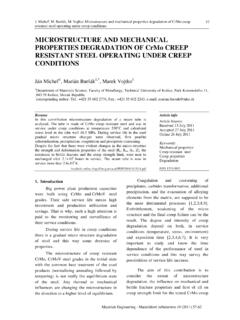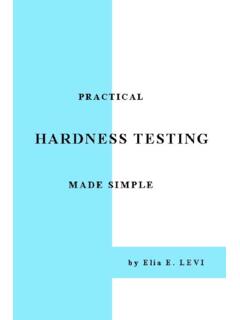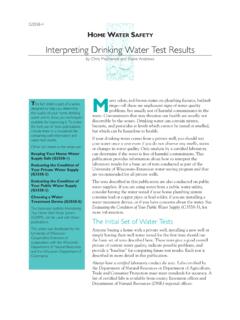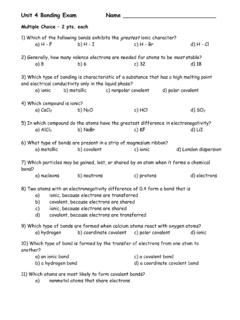Transcription of CORRELATION BETWEEN HARDNESS AND TENSILE …
1 M. Ga ko, G. Rosenberg: CORRELATION BETWEEN HARDNESS and TENSILE properties in ultra-high strength dual phase steels short communication Materials Engineering - Materi lov in inierstvo 18 (2011) 155-159 155 CORRELATION BETWEEN HARDNESS AND TENSILE PROPERTIES IN ULTRA-HIGH STRENGTH DUAL PHASE STEELS SHORT COMMUNICATION Martin Ga ko1,*, Gejza Rosenberg1 1 Institute of materials research, Slovak Academy of Sciences, Watsonova 47, 040 01 Ko ice - Slovakia *corresponding author: Tel.: +421 55 729 2473, e-mail: Resume The possibility to predict yield strength, strength limit, fatigue live estimation as well as other mechanical properties depending on values of materials HARDNESS is commonly known and it is often used in practice. The main aim of this contribution is to review the possibilities of application of CORRELATION relationships BETWEEN HARDNESS and ultimate TENSILE strength of steel sheets in various structural states.
2 The experiments were performed on advanced steels with structure which is composed from ferrite and martensite (dual phase steels). Available online: Article info Article history: Received 27 May 2011 Accepted 28 July 2011 Online 3 November 2011 Keywords: Dual phase steel Vickers HARDNESS Mechanical properties ISSN 1335-0803 1. Introduction Although, basically the HARDNESS test of the metal materials evaluates only surface resistance of the material against the plastic deformation, the HARDNESS test is frequently used because it represents cheap non-destructive and simple method for assessment of various material properties like yield strength, TENSILE strength, fatigue limit, but also distribution of residual strains and, in a case of brittle materials, fracture toughness [2-4].
3 In order to determine the relationship BETWEEN the ultimate TENSILE strength (UTS) and HARDNESS (H) a number of relations were established [2-4]. In practice, the simplest equation is most often used: (1) where k is coefficient. In contribution [1], the coefficient was in range from to for steel, from to for brass and from to for nodular iron (the HARDNESS was measured according to Brinell, HB). Fig. 1 shows the progress of UTS in dependence on HB for different materials [1-3]. For aluminium alloys, in comparison with steels, generally the smaller values of coefficient k are observed ( ). This can be well seen from results mentioned in Fig. 1 based on work [3].
4 In this contribution the fact that the value of coefficient k, in dependence on microstructure state (SDAS secondary dendrite arm spacing), is in the range from to was found. At the steels, the coefficient k ranges the most frequently in the interval from to According to standard SN 420379, which is replaced now by STN EN ISO 18265, in dependence on applied heat treatment or heat mechanical treatment, the influence of microstructure on CORRELATION of TS-HB is reflected by the ratio of yield strength and TENSILE strength of steel. By this standard [2], for the ratio YS/TS in range from to the coefficient k in the range from to (with increase the ratio YS/TS low value of k is recommended to use) is recommended to use. In present, there exist a number of CORRELATION M.
5 Ga ko, G. Rosenberg: CORRELATION BETWEEN HARDNESS and TENSILE properties in ultra-high strength dual phase steels short communication Materials Engineering - Materi lov in inierstvo 18 (2011) 155-159 156 relationships HB UTS a HB YS type, where besides the empirical coefficients, many other material characteristics are involved. For example, the equations by Cahoon et al. are among the most known which include the strain hardening exponent [3]. The utilizing of the high strength steels constantly increases in the entire area of industry. The high demands on strength and plastic properties of the steel sheets for automotive industry intended for the autobody are placed. Among all advanced high strength steels the dual phase steels (DP) are most often used for automotiv industry.
6 By comparison to conventional steels, DP steels have significantly better combination values of strength versus ductility and a very good compressibility. The high plasticity of DP steels is given by microstructure consisting of soft ferrite and hard martensite. In consequence of this, these steels are also known by low value of YS/TS ratio (mostly YS/TS = to , valid even for steels with strength over the 1000 MPa) [5,6]. The main aim of this work was to find out how the individual composition of microstructure and low ratio YS/TS results in value of coefficient k and, at the same time, with which accuracy it is possible to predict YS and TS of these steels, by the Vickers HARDNESS testing. 2. Experimental material For experiments five low carbon steels with carbon content C = - % and manganese content Mn = - % were used.
7 All steels were processed with two modes of intercritical annealing consisting of heating on 750 C or 800 C (10 minutes hold) and consequential quenching in water. The volume fraction of martensite was in range from 20 to 60 %. The TENSILE properties was measured on specimens, which were 120 mm long, and 10 mm wide, with starting measured length L0 = 50 mm (thickness of specimens was in range from s = to s = mm). In this study the CORRELATION of relationship in form TS - HV, YS - HV, YS/TS - HV5 as well as the CORRELATION BETWEEN strain hardening exponent and HARDNESS : n - HV was examined. 3. Results and discussion Among the all studied correlations , as expected, the highest coefficient of CORRELATION was found BETWEEN HARDNESS and strength.
8 However, also in this case, the CORRELATION coefficient did not attain the value R2 = , therefore the interdependence BETWEEN strength and HARDNESS is relatively low. The results show that the prediction of UTS value based on the measurement of values of HV5 could be loaded UTS - HBSteel [2] Steel[1] BrassCast iron (nodular)Al-Si-Mg (A356) f ine SDASAl-Si-Mg large SDAS200400600800100012001400901401902402 90340 HBU T S [ M Pa] Fig. 1. Plot of ultimate TENSILE strength of various materials as a function of HARDNESS [1-3] M. Ga ko, G. Rosenberg: CORRELATION BETWEEN HARDNESS and TENSILE properties in ultra-high strength dual phase steels short communication Materials Engineering - Materi lov in inierstvo 18 (2011) 155-159 157 by considerable error. The biggest scatter of data is observed in the range from 270 to 325 HV5.
9 The anticipated strength (UTS calculated from equation on Fig. 2) is in comparison with the strength based on TENSILE test measurement in the range UTS 125 MPa. When we take into account all measured values mentioned in , and the shape of CORRELATION equation (1) then we detect that the coefficient k is in the range from to The CORRELATION coefficient for the relation YS = f (HV5) is less than R2 = This result clearly shows that the prediction of the yield stress of steel through the measured values of HARDNESS is loaded with larger error as it was in the case of strength prediction. Measured results in Fig. 3 indicate that the relation YS = f (HV5) at HARDNESS over the 325 units HV5 is steeper. The slope in the established equations reaches more than three times higher values (Fig.)
10 3). It is likely that for the YS - HV5 CORRELATION using the equation in exponential form would be more suitable. Also in the relation YS / UTS = f (HV5), for the same HARDNESS , it is possible to observe the break. From the set of CORRELATION equations it is clear that, for the HARDNESS of about 330 units HV5, the relation shows a minimum (Fig. 4). In practical terms we cannot speak about CORRELATION of YS / UTS - HV5, because CORRELATION coefficient is low. The data in Fig. 4 show that in the range from 210 to 330 units of HV5 the values of ratio YS / UTS are in the range from to , and the HARDNESS from 370 to 430 units of HV5 results in the ratio YS / UTS = to Fig. 2. Ultimate TENSILE strength as a function of HARDNESS HV5 UTS - HV5y = 2,77x + 92,754R2 = 0,87866007008009001000110012001300140020 0250300350400450HV5U T SFig.







